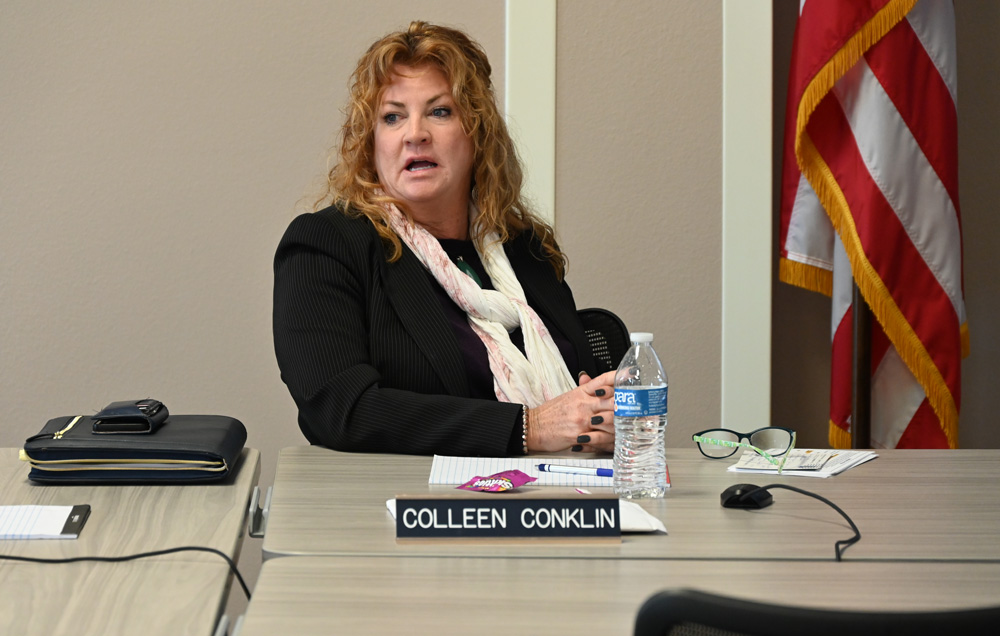
Speaking publicly for the first time about the revelation last month that county government was looking to pull back its share of funding for $1.4 million in “legacy” programs it helps pay for in the school district, including about $1 million for school resource deputies, Flagler County School Board member Colleen Conklin today asked for a public conversation, and said “disinformation” has obscured the fact that at one time, more than two decades ago, the county paid for the entirety of the bill.
Today the county and the district share the roughly $2 million cost of having 14 deputies on the district’s nine traditional school campuses, including two at each high school and one at a relatively new traditional school.
In February County Administrator Heidi Petito sent a letter to Superintendent LaShakia Moore saying that the decision had been made to rethink and pull back the county’s “legacy” contributions. The county commission had not actually reached that decision. It had only directed the administrator to explore legacy commitments in view of the commission possibly pulling back. Petito and Moore met shortly after the letter’s revelation here. Petito briefed the commission on that meeting in a 30-second update. Moore had spoken of it in an interview with FlaglerLive, but not briefed the board.
“There are some significant dollars there that I don’t believe that we’re prepared to absorb,” Conklin said. “I just feel like we haven’t had a conversation about this. I’d really like for us to have a conversation.”
Moore said she and two district directors met with Petito some time back, only to talk. No decisions had been made. “The crux of the conversation was around identifying dollars that are available to the school district, to the county, to the communities through grants potentially,” Moore said. “How do we utilize all dollars available to us in order to ensure that the programs that the county supports remains affordable. We did have a conversation around the half cent sales tax providing some clarity onto the changes that were made to allow for the half cent sales tax to address some safety measures. But those changes do not allow for us to pay for personnel out of that.”
When voters approved the renewal of the district’s half-penny sales surtax for another 10 years in 2022, the measure granted the district the authority to spend some of the money on security as long as it’s not for personnel or recurring dollars. The money must be spent on capital needs or equipment. In that sense, the district could pay for sheriff’s deputies’ cars, weapons, ammunition, bulletproof vests. All those costs are folded into the more than $125,000-per-deputy cost the district pays for, and would potentially lower the costs borne by other dollars.
Since the district receives all of its share’s money for deputies through the Safe Schools allocation, it has no incentive to spend money from its own pots to increase its share of the burden. That’s what the county and perhaps the Sheriff’s Office may seek to change.
“Our conversation never included anything that implied that they were not still committed to those projects,” Moore said. “But we’re looking at our budget. We’re looking at all the things that we pay for within our budget that are not our sole responsibility, our statutory responsibility, and we’re having conversations with individuals where those commitments lie, and we said we will come back together and continue to have a conversation. We did make it very clear in that conversation that it would not be appropriate for staff to have a conversation in a staff meeting and make a decision that really lies in the hands of elected officials.”
+
Moore was adamant about that. Conklin was equally adamant about past practices.
“Historically we’ve had SROs in our schools,” Conklin said. “I’m talking about back in the 90s. And they were fully funded by the county. And so there seems to be some folks that have forgotten that, and that over the years that funding responsibility has shifted, whereas this should be a community effort. This should not just fall on the school district.”
“So this notion that this is a new thing, it’s not new,” Conklin said. She was mostly right. But one essential thing changed after the 2018 mass killing at a Parkland high school: the legislature passed a law requiring at least one armed person on every public school campus, and to help defray the cost, approved a Safe Schools allocation for every county. The allocations don;t come near to covering the cost. In Flagler County, the annual allocation has been a little over half the cost of the 13 deputies in traditional schools, and this year it was just about half, now that the district has added one more deputy to the total–security at the alternative school on the campus of Flagler Palm Coast High School.
Conklin says she understands the county’s interest in rethinking its allocations. “But that is a shared responsibility to keep our students safe,” she said, using words that the superintendent has used previously, and that even county commissioners are using. Commission Chairman Andy Dance, who had himself raised the issue of legacy funding at the district, pulled back from any suggestion that he’d want the shared responsibility eliminated. He said the aim is to look at different ways to assume that responsibility, if it’s available.
Twice Conklin said that the county in the past funded the program “100 percent.” The claim could not be verified, but Conklin has been on the school board since 2000. What is certain is that the number of deputies in schools has fluctuated, as has the share between county and district coffers. The district at one point when Don Fleming was sheriff was paying 60 percent of the share.
It’s not clear to what extent conversations are continuing. But Moore seemed intent on reassuring her board that she would not be stepping out in any way in policy-making’s direction.








